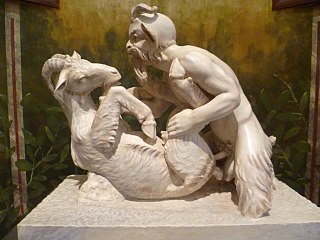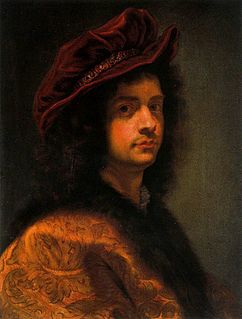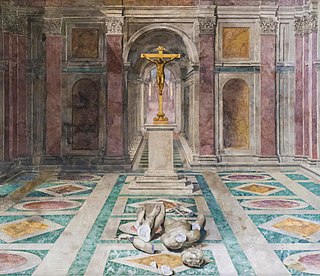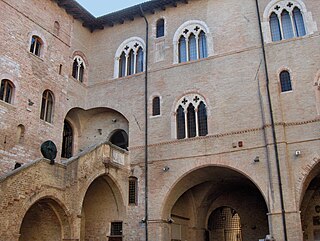
Erotic art in Pompeii and Herculaneum has been both exhibited as art and censored as pornography. The Roman cities around the bay of Naples were destroyed by the eruption of Mount Vesuvius in 79 AD, thereby preserving their buildings and artefacts until extensive archaeological excavations began in the 18th century. These digs revealed the cities to be rich in erotic artefacts such as statues, frescoes, and household items decorated with sexual themes. The ubiquity of such imagery and items indicates that the treatment of sexuality in ancient Rome was more relaxed than current Western culture. However, much of what might strike modern viewers as erotic imagery, such as oversized phalluses, could arguably be fertility imagery. Depictions of the phallus, for example, could be used in gardens to encourage the production of fertile plants. This clash of cultures led to many erotic artefacts from Pompeii being locked away from the public for nearly 200 years.

Giovanni Battista Tiepolo, also known as GiambattistaTiepolo, was an Italian painter and printmaker from the Republic of Venice who painted in the Rococo style, considered an important member of the 18th-century Venetian school. He was prolific, and worked not only in Italy, but also in Germany and Spain.

Luca Giordano was an Italian late-Baroque painter and printmaker in etching. Fluent and decorative, he worked successfully in Naples and Rome, Florence, and Venice, before spending a decade in Spain.

The art of Europe, or Western art, encompasses the history of visual art in Europe. European prehistoric art started as mobile Upper Paleolithic rock and cave painting and petroglyph art and was characteristic of the period between the Paleolithic and the Iron Age. Written histories of European art often begin with the art of Ancient Israel and the Ancient Aegean civilizations, dating from the 3rd millennium BC. Parallel with these significant cultures, art of one form or another existed all over Europe, wherever there were people, leaving signs such as carvings, decorated artifacts and huge standing stones. However a consistent pattern of artistic development within Europe becomes clear only with the art of Ancient Greece, adopted and transformed by Rome and carried; with the Roman Empire, across much of Europe, North Africa and Western Asia.

The Walters Art Museum, located in Mount Vernon-Belvedere, Baltimore, Maryland, United States, is a public art museum founded and opened in 1934. It holds collections established during the mid-19th century. The Museum's collection was amassed substantially by major American art and sculpture collectors, a father and son: William Thompson Walters, (1819–1894), who began collecting when he moved to Paris as a nominal Southern/Confederate sympathizer at the outbreak of the American Civil War in 1861; and Henry Walters (1848–1931), who refined the collection and made arrangements for the construction of a later landmark building to rehouse it. After allowing the Baltimore public to occasionally view his father's and his growing added collections at his West Mount Vernon Place townhouse/mansion during the late 1800s, he arranged for an elaborate stone palazzo-styled structure built for that purpose in 1905–1909. Located across the back alley, a block south of the Walters mansion on West Monument Street/Mount Vernon Place, on the northwest corner of North Charles Street at West Centre Street.

Ca' Rezzonico is a palazzo on the Grand Canal in the Dorsoduro sestiere of Venice, Italy. It is a particularly notable example of the 18th century Venetian baroque and rococo architecture and interior decoration, and displays paintings by the leading Venetian painters of the period, including Francesco Guardi and Giambattista Tiepolo. It is a public museum dedicated to 18th-century Venice and one of the 11 venues managed by the Fondazione Musei Civici di Venezia.

Giovanni Domenico Tiepolo was an Italian painter and printmaker in etching. He was the son of artist Giovanni Battista Tiepolo and elder brother of Lorenzo Baldissera Tiepolo.

Giovanni Battista Gaulli, also known as Baciccio or Baciccia, was an Italian artist working in the High Baroque and early Rococo periods. He is best known for his grand illusionistic vault frescos in the Church of the Gesù in Rome, Italy. His work was influenced by Gian Lorenzo Bernini.

Giuseppe Maria Crespi, nicknamed Lo Spagnuolo, was an Italian late Baroque painter of the Bolognese School. His eclectic output includes religious paintings and portraits, but he is now most famous for his genre paintings.

Carlo Maratta or Maratti was an Italian painter, active mostly in Rome, and known principally for his classicizing paintings executed in a Late Baroque Classical manner. Although he is part of the classical tradition stemming from Raphael, he was not exempt from the influence of Baroque painting and particularly in his use of colour. His contemporary and friend, Giovanni Bellori, wrote an early biography on Maratta.

Sebastiano Ricci was an Italian painter of the late Baroque school of Venice. About the same age as Piazzetta, and an elder contemporary of Tiepolo, he represents a late version of the vigorous and luminous Cortonesque style of grand manner fresco painting.

Tommaso Laureti, often called Tommaso Laureti Siciliano, was an Italian painter from Sicily who trained in the atelier of the aged Sebastiano del Piombo and worked in Bologna. From 1582, he worked for papal patrons in Rome in a Michelangelo-inspired style with special skill in illusionistic perspective, that in his Roman work avoided all but traces of Mannerism.

Etruscan art was produced by the Etruscan civilization in central Italy between the 10th and 1st centuries BC. From around 750 BC it was heavily influenced by Greek art, which was imported by the Etruscans, but always retained distinct characteristics. Particularly strong in this tradition were figurative sculpture in terracotta, wall-painting and metalworking especially in bronze. Jewellery and engraved gems of high quality were produced.

The Battle of Utica was fought in 203 BC between armies of Rome and Carthage during the Second Punic War. Through a surprise attack, the Roman commander Scipio Africanus managed to destroy a numerous force of Carthaginians and their Numidian allies not far from the outflow of the Medjerda River in modern Tunisia. Thus he gained a decisive strategic advantage, switched the focus of the war from Italy and Iberia to Carthaginian north Africa, and contributed largely to the final Roman victory.

The Trinci Palace is a patrician residence in the center of Foligno, central Italy. It houses an archaeological museum, the city's picture gallery, a multimedia museum of Tournaments and Jousts and the Civic Museum.

The Continence of Scipio, or The Clemency of Scipio, is an episode recounted by Livy of the Roman general Scipio Africanus during his campaign in Spain during the Second Punic War. He refused a generous ransom for a young female prisoner, returning her to her fiancé Allucius, who in return became a supporter of Rome. In recognition of his magnanimous treatment of a prisoner, he was taken as one of the prime examples of mercy during warfare in classical times. Interest in the story revived in the Renaissance and the episode figured widely thereafter in both the literary and visual arts, as well as opera.

Publius Cornelius Scipio Africanus was a Roman general and statesman, most notable as one of the main architects of Rome's victory against Carthage in the Second Punic War. Often regarded as one of the best military commanders and strategists of all time, his greatest military achievement was the defeat of Hannibal at the Battle of Zama in 202 BC. This victory in Africa earned him the epithet Africanus.
Gerolamo Mengozzi Colonna was an Italian painter, mostly of frescoed quadratura.

The Ca' Dolfin Tiepolos are a series of ten oil paintings made c.1726–1729 by Giovanni Battista Tiepolo for the main reception room or salone of the Palazzo Ca' Dolfin, the palazzo of the patrician Dolfin family in Venice. The paintings are theatrical depictions of events from the history of Ancient Rome, with a typically Venetian emphasis on drama and impact rather than historical accuracy. They were painted on shaped canvases and set into the architecture with frescoed surrounds.

Masinissa, also spelled Massinissa, Massena and Massan, was an ancient Numidian king best known for leading a federation of Massylii Berber tribes during the Second Punic War, ultimately uniting them into a kingdom that became a major regional power in North Africa.



















